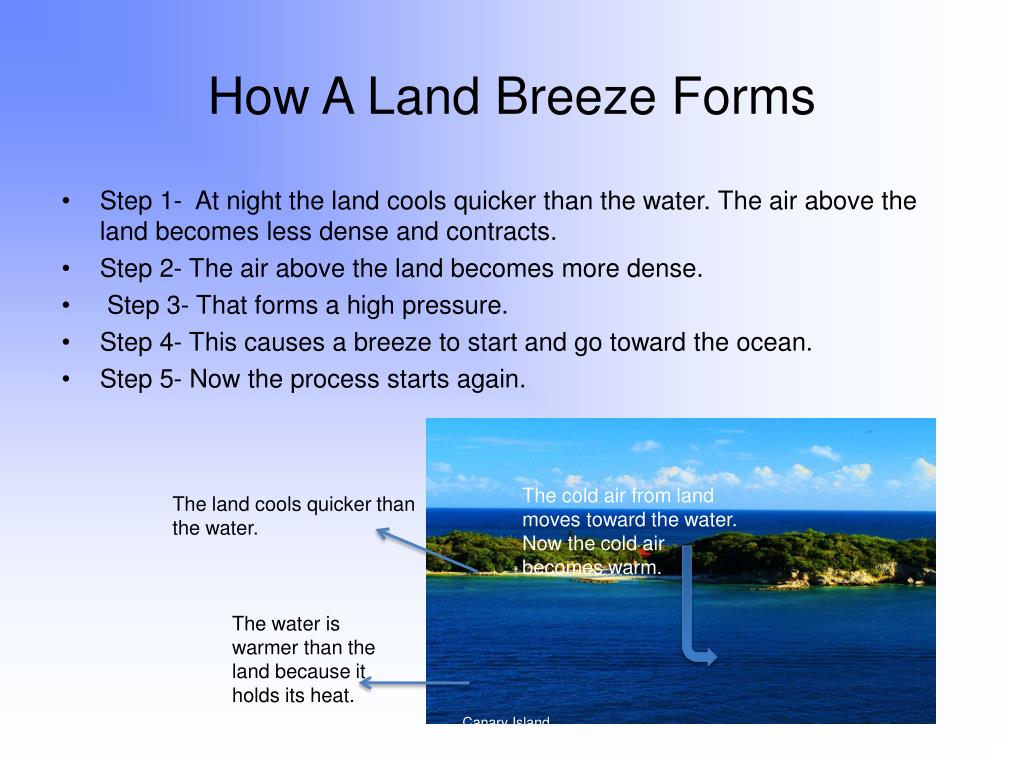
These winds collide with cold, dry air moving in from an area of low pressure. This hot spot acts as a pivot point for winds circling it. These winds often cause the air to come together in a system called a “ hot spot.” ThunderstormsĪs the land heats up, hot air rises and starts winds in the atmosphere. This process draws up cool air from the water and usually causes heavy mist or even fog, known as a sea or lake haze. Distinct Features and Characteristics of a Land Breeze High Humidity at Seaĭuring the day, land breezes bring a large amount of warm air from inland.
/GettyImages-687531229-0be24eded296454688dc4cdc34b975d2.jpg)
The air over the ocean then flows onto the land to equalize the pressure. Because of this, it develops lower pressure than the sea. Since water has a higher specific heat capacity, the temperature of the land cools at a slower rate during the night than the seawater. This is because changing the temperature of land takes less energy than changing water.Ī land breeze is a warm air blowing off the land. Land heats and cools more quickly than water. The drive to get things done.To understand what causes a land breeze, it’s crucial first to understand the difference in heating of both land and sea.
Land breeze skin#
Sea air contains iodine, salt, and magnesium, which can help with asthma symptoms, respiratory health, allergies, and skin problems, as well as stimulate the immune system. That sea breeze smells wonderful for many reasons than just the promise of leisure. The sea breeze can bring relief from oppressive heat, produce thunderstorms, provide moisture for fog, and improve or degrade air quality near the Earth's surface. The cooler air over the ocean flows across the land surface to replace the rising warm air as the warm air over the land rises. The land surface heats up faster than the sea surface during the day. As a result, you'll notice a substantial temperature drop and an outstanding cooling impact.Īlso read: NCERT Solutions for Class 8 Science Chapter 15- Some Natural Phenomenaīecause land and water heat at different rates, sea breezes occur during hot summer days. On hot, bright days in the spring and summer, the sea breeze is stronger. The sea breeze is the movement of air from the sea to the land. The air flows from the high pressure over the sea to the low pressure over the land because to the pressure difference.

A high-pressure area forms on the sea's surface at the same moment. Expansion happens in the less dense warm air, resulting in the formation of a low-pressure zone over the continent. As a result, the temperature above the ground surface rises, warming the surrounding air. Because the sea has a far higher heat capacity than the land, it heats up more slowly. The sun heats both the sea and the land's surface. This procedure is repeated throughout the day. Difference Between Land Breeze and Sea Breeze.The land gets heated faster than the sea, so the air on the land rises up and move towards the sea and the cool air in the sea moves towards the land to 'occupy the space' above the landĪ land breeze or an offshore breeze, on the other hand, is the result of rivers drying land more faster than water, and after sunset, the sea breeze diminishes and the wind then moves from land to sea sea breezes are most essential in coastal areas prevailing winds. The stronger the wind is, once again, the greater the temperature difference between the two. The contrast in cooling rates between the land and the ocean causes it. The land wind is a nighttime coastal breeze that blows from land to sea.

Land breezes can happen at any time of year, although they're more common in the fall and winter when water temperatures are still warm and nights are cool. As a result, air rushes from the land to the sea, resulting in the land breeze.

As a result of the higher temperature above the water compared to the land, a low-pressure condition develops over the sea. Because the land has a lower heat capacity than the sea, it cools off faster. When the sun sets, both the land and the sea begin to cool. This process continues throughout the night, and then the above-mentioned process is reversed. What is Land Breeze and Sea Breeze? Define Land Breeze:.


 0 kommentar(er)
0 kommentar(er)
